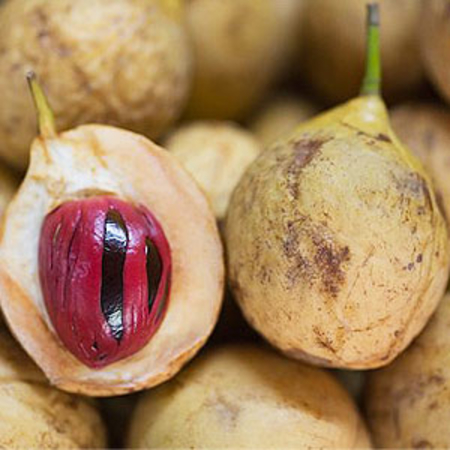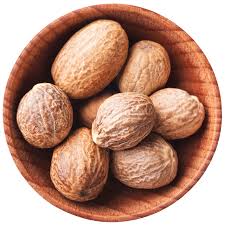





Botanical name Myristica fragrans
Family Myristicaceae
Source Kernels
Origin Indonesia
Processing Method Steam Distilled.
Color/Consistency A thin, colourless to pale yellow liquid.
Aromatic Summary / Note / Strength of Aroma A middle note of medium aroma, Nutmeg's scent is soft, spicy, and woody with a slightly musky note.
Blend with Petitgrain, Lavender, Geranium, Orange, Clary Sage, Rosemary and other Spice Oils.
Product Abstract
Nutmeg is a spice which has a power full fragrance and uses all Indian kitchens. It’s a very important spice as well as it used to remedy different types of diseases from years. Nutmeg oil is very helpful joint pain and muscular ache as it is a relaxing treatment for body. Nutmeg has power to treat pain, stress, heart diseases, indigestion, and control blood pressure, cough cold menstrual disorders and respiratory problems. Nutmeg essential oil is also used in aromatherapy. Nutmeg is extracted by steam distillation method from the hard seed, it’s seems Like small ball.
History
Until the mid-19th century, the small island group of the Banda Islands, which are also known under the name "Spice Islands," was the only location of the production of the spices nutmeg and mace in the world. The Banda Islands are situated in the eastern part of Indonesia, in the province of Maluku. They consist of eleven small volcanic islands, called Neira, Gunung Api, Banda Besar, Rhun, Ai, Hatta, Syahrir, Karaka, Manukan, Nailaka and Batu Kapal, with a total approximate land area of 8,150 hectares .
Harvesting/Extraction Information
Nutmeg is a delicate, slightly sweet spice that is widely used in cuisines around the world. The tree is also highly valued because of the essential oils derived from the tree and leaves, and nutmeg butter is also a popular derivative food that packs a healthy punch. The essential oils from nutmeg steam extract are highly beneficial to health and are frequently used in alternative and herbal medicine.
Common Usage
Caution
Nutmeg has come under considerable suspicion since the cases of accidental poisoning have increased in recent years. Excessively consuming it can have psychotropic, hallucinatory, or narcotic effects on people, and many people tried to duplicate those effects recreationally. Unfortunately, consuming a huge amount of nutmeg can complicate your bodily processes, as it is a potent spice meant to be used in small quantities. Consuming too much of it can result in seizures, irregular heart, palpitations, and vomiting.
Key constituents
Sabinene 42.0–57.0%
a-Pinene 1.6–12.6%
b-Pinene 7.8–12.1%
Terpinen-4-ol 3.0–6.4%
g-Terpinene 1.7–4.7%
(þ)-Limonene 2.9–4.4%
a-Terpinene 0.8–4.2%
b-Myrcene 2.2–3.4%
p-Cymene 0.7–3.2%
E)-Sabinene hydrate 0.3–2.4%
Terpinolene 1.4–1.7%
Elemicin 1.2–1.4%
a-Thujene 1.2%
(Z)-p-Piperitol 0.4–.2%
Myristicin 0.5–0.9%
Safrole 0.1–0.5%
Methyleugenol 0.1–0.2%
Safety summary
Hazards Potentially carcinogenic, based on safrole and methyleugenol content; psychotropic in high doses.
Contraindications None known.
Maximum adult daily oral dose (Indian nutmeg oil) 28 mg
EU 0.016%
IFRA 0.03%
Tisserand & Young 0.8%
Our safety advice
We recommend a dermal maximum of 0.8% for the Indian oil based on 3.3% safrole and 1.2% methyleugenol content, and 5% for the Indian oil based on 0.5% safrole and 0.2% methyleugenol content, applying dermal limits of 0.05% and 0.02% for safrole and methyleugenol, respectively. The maximumdaily oral doses are based on 0.025 mg/kg for safrole and 0.01 mg/kg for methyleugenol.
Regulatory guidelines
IFRA recommends a maximum concentration of 0.0004% methyleugenol in leave-on products such as body lotions. The equivalent SCCNFP maximum is 0.0002%. IFRA and the EU recommend a maximum exposure level of 0.01% of safrole from the use of safrole-containing essential oils in cosmetics.
Organ-specific effects
Adverse skin reactions Undiluted nutmeg oil was moderately irritating to rabbits; tested at 2% on 25 volunteers it was neither irritating nor sensitizing.
Neurotoxicity Whole nutmeg has been known for its narcotic, intoxicating properties since the sixteenth century.
Psychotropic effects have been reported for whole nutmeg in high doses. Myristicin and elemicin are thought to be responsible, but other synergistic elements may need to be present for a psychotropic effect to take place. There is little information concerning psychotropic effects for the essential oil. One of us has ingested 1 mL of nutmeg oil with no noticeable effect, and 1.5 mL which resulted in a moderately strong psychotropic effect. Three other individuals each ingested 1.5 mL of nutmeg oil, and two experienced psychotropic effects. See Ch. 10, p. 145 for cases of nutmeg intoxication.
Reproductive toxicity The administration of nutmeg oil at up to 260 mg/kg to pregnant rats for 10 consecutive days, up to 560 mg/kg to pregnant mice for 10 consecutive days, and up to 600 mg/kg to pregnant hamsters for five consecutive days had no effect on implantation or on maternal or fetal survival; no teratogenic effect was observed in comparison with controls. Sabinene is not reproductively toxic. A 30-year-old woman, at 30 weeks of gestation, ingested several cookies made with 7 g of ground nutmeg, instead of the recommended one-eighth of a teaspoon. Four hours later she experienced a sudden onset of palpitations, blurred vision, agitation and a sense of impending doom. The fetal heartbeat was 160–170 bpm, and returned to a baseline of 120–140 within 12 hours. The fetal response was attributed to the myristicin content of nutmeg oil, and its anticholinergic effect. It is thought that myristicin readily crosses the placenta. This case, with its assumed conclusions, is not a sufficient basis to contraindicate nutmeg oil in pregnancy.
Systemic effects
Acute toxicity Nutmeg oil acute oral LD50 has been reported as 2.62 g/kg and 2.6 g/kg in rats, 5.6 g/kg in
mice and 6 g/kg in hamsters; acute dermal LD50 in rabbits >10 mL/kg.
Antioxidant/pro-oxidant activity Nutmeg oil has demonstrated significant antioxidant activity in vitro and in vivo. It showed potent DPPH radical scavenging activity, with an IC50 of 0.13 mL/mL.
Carcinogenic/anticarcinogenic potential Nutmeg oil contains both rodent carcinogens and anticarcinogens. Methyleugenol and safrole are carcinogenic and (þ)-limonene and myristicin display anticarcinogenic activity. Nutmeg oil was not mutagenic in the Ames test, and did not produce CA in Chinese hamster fibroblasts. Nutmeg oil dose-dependently inhibited aflatoxin B1-induced adducts in calf thymus DNA, in the presence of rat liver microsomes. Nutmeg oil significantly induced glutathione S-transferase in mouse liver.
Drug interactions Nutmeg oil is a weak inhibitor of MAO, not at a level suggestive of drug interaction.
Comments
While nutmeg oil contains both carcinogens and anticarcinogens, the anticarcinogens are present in higher concentrations, and the existing data suggest either that the oil is not carcinogenic or that it is anticarcinogenic. If myristicin is important in any of the therapeutic actions of nutmeg oil, the Indian oil might be more useful than the Sri lnakan oil. Camphene has been cited as the major constituent of nutmeg oil, but this is a historical error. The 1989 edition of the Merck Index cites camphene as constituting 60–80% of nutmeg oil. Guenther cites a 1907 reference from Power and Salway, in which ‘d-pinene’ and ‘d-camphene’ were identified as constituting 80% of nutmeg oil. However, any analysis published since about 1970 shows sabinene as the major constituent, with camphene occurring at 0–0.6%.